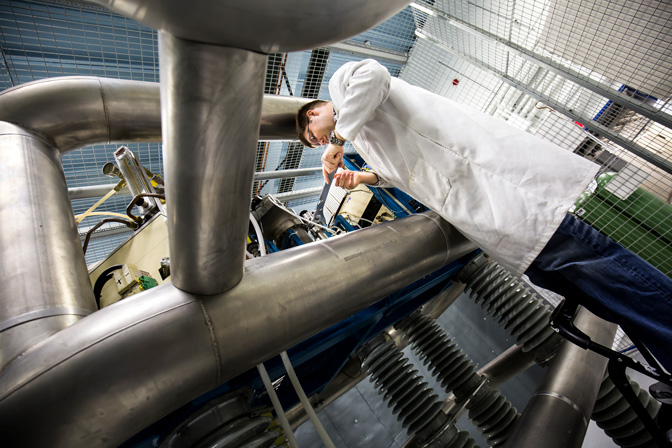
$7.5M to advance nuclear energy awarded to U-M
The Department of Energy will support research into faster reactor licensing, just energy transitions, and more.

The Department of Energy will support research into faster reactor licensing, just energy transitions, and more.
In an effort to speed the licensing of advanced nuclear reactors, ensure that communities are respected during reactor siting, monitor and limit corrosion in nuclear reactors, and more, the Department of Energy (DOE) has awarded $7.5 million to Michigan Engineering researchers.
The biggest project U-M leads, funded with $3 million from DOE’s Integrated Research Projects program, aims to speed up the advanced nuclear reactor licensing process by building a tool that gives companies the data needed for design approval.
The Nuclear Regulatory Commission requires extensive data about how new reactors will operate over time, up to 20 years. Companies need to show that the parts of the reactor can survive the radiation and other stresses. Test reactors are slow and expensive—and these days, not very available.
As an alternative, the U-M team will shoot atomic nuclei at the material, a technique known as ion irradiation, to create a predictive tool that advanced reactor companies can use to show how well their core materials can withstand decades’ worth of radiation damage.
“Ion irradiation is not only faster, in terms of days versus years, and cheaper—thousands versus millions of dollars—it also does not require special handling or disposal issues, and advances in ion irradiation techniques and simulation and modeling have established the technique as a viable substitution for reactor irradiation,” said Gary Was, professor emeritus of nuclear engineering and radiological sciences, who leads the project.
Other U-M contributors include Kevin Field, a professor of nuclear engineering and radiological sciences, and Emmanuelle Marquis, a professor of materials science and engineering. The project includes collaborators at the University of Tennessee, Pennsylvania State University, Prairie View A&M University, Texas A&M University, Oak Ridge National Laboratory, Los Alamos National Laboratory, Idaho National Laboratory, and Pacific Northwest National Laboratory.
In addition, four projects are funded with $1 million each by the Nuclear Energy University Partnerships Program (NEUP).
A tool for engaging communities on the clean energy transition. Nuclear energy has been stymied in part due to public opinion in the areas around potential plant sites, but it is a critical part of the transition to a zero-emissions grid. Aditi Verma, an assistant professor of nuclear engineering and radiological sciences with the U-M Fastest Path to Zero Initiative, will lead a survey of communities in New Mexico exploring views on clean energy, nuclear energy and a just energy transition.They’ll use their findings to build a tool that assesses public sentiment and helps match technology developers with communities.
Real-time impurity detection. Sodium-cooled fast reactors have meltdown-proof designs and could run on spent fuel from our current fleet of water-cooled reactors. However, impurities like oxygen and hydrogen can get into the sodium coolant and cause problems like corrosion and blockages. Milos Burger, an assistant research scientist in nuclear engineering and radiological sciences, leads a team that will develop better sensors to monitor impurities in sodium-cooled fast reactors. In addition to being more sensitive than current sensors, they will be able to identify the type of impurity—which can help reveal the source of the contamination.

Determining how radiation degrades reactor components. Stresses in nuclear reactors—including radiation, pressure, and heat—can change the shape of components. A team led by Field will develop a quick and cost-effective method to test materials under different cyclic stresses and varying heat conditions during ion irradiations. They will use a rig that can vary the stretching a material experiences throughout an ion beam experiment. They’ll start with two alloys used in advanced reactor designs.
Ultrasonic imaging to assess reactor parts. Some next-gen nuclear reactor parts are 3D printed to reduce manufacturing time and costs, but defects like little holes where the layers didn’t stick together could cause parts to fail if they are used. A team led by Serife Tol, an assistant professor of mechanical engineering, will develop advanced ultrasonic imaging to look for such defects so that these parts can be approved.
Finally, a project that will help nuclear scientists and technologists prepare for the quantum revolution is funded with an additional $500,000 from NEUP. Algorithms that work on current computers won’t work on quantum computers. While others are already at work on how to simulate fluids with quantum computers, neutrons—the particles responsible for triggering fission in nuclear reactors—need attention. A team led by Brian Kiedrowski, a professor of nuclear engineering and radiological sciences, will begin to encode the behaviors of neutrons in a way that quantum computers can understand.